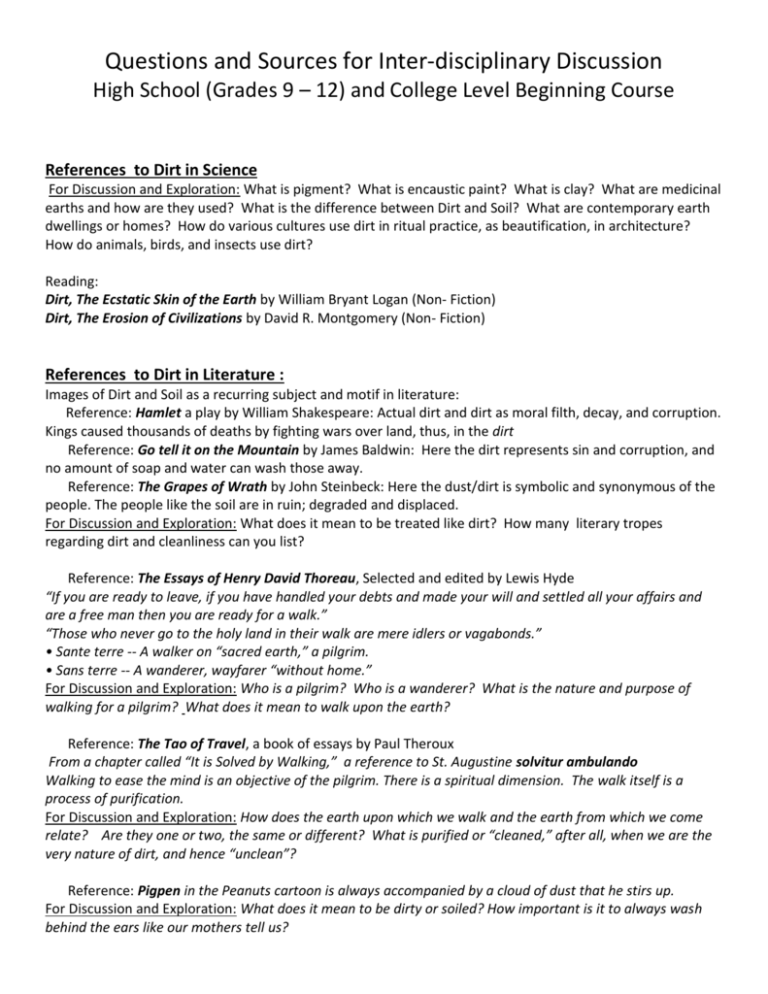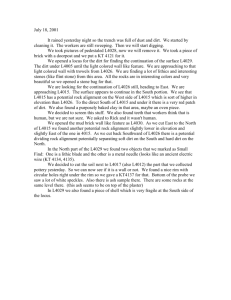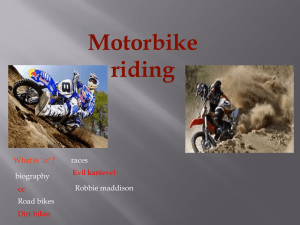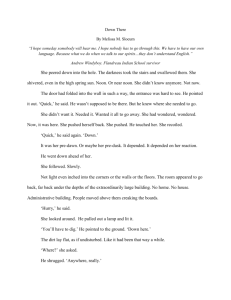Questions and Sources for Inter-disciplinary Discussion (.doc)
advertisement

Questions and Sources for Inter-disciplinary Discussion High School (Grades 9 – 12) and College Level Beginning Course References to Dirt in Science For Discussion and Exploration: What is pigment? What is encaustic paint? What is clay? What are medicinal earths and how are they used? What is the difference between Dirt and Soil? What are contemporary earth dwellings or homes? How do various cultures use dirt in ritual practice, as beautification, in architecture? How do animals, birds, and insects use dirt? Reading: Dirt, The Ecstatic Skin of the Earth by William Bryant Logan (Non- Fiction) Dirt, The Erosion of Civilizations by David R. Montgomery (Non- Fiction) References to Dirt in Literature : Images of Dirt and Soil as a recurring subject and motif in literature: Reference: Hamlet a play by William Shakespeare: Actual dirt and dirt as moral filth, decay, and corruption. Kings caused thousands of deaths by fighting wars over land, thus, in the dirt Reference: Go tell it on the Mountain by James Baldwin: Here the dirt represents sin and corruption, and no amount of soap and water can wash those away. Reference: The Grapes of Wrath by John Steinbeck: Here the dust/dirt is symbolic and synonymous of the people. The people like the soil are in ruin; degraded and displaced. For Discussion and Exploration: What does it mean to be treated like dirt? How many literary tropes regarding dirt and cleanliness can you list? Reference: The Essays of Henry David Thoreau, Selected and edited by Lewis Hyde “If you are ready to leave, if you have handled your debts and made your will and settled all your affairs and are a free man then you are ready for a walk.” “Those who never go to the holy land in their walk are mere idlers or vagabonds.” • Sante terre -- A walker on “sacred earth,” a pilgrim. • Sans terre -- A wanderer, wayfarer “without home.” For Discussion and Exploration: Who is a pilgrim? Who is a wanderer? What is the nature and purpose of walking for a pilgrim? What does it mean to walk upon the earth? Reference: The Tao of Travel, a book of essays by Paul Theroux From a chapter called “It is Solved by Walking,” a reference to St. Augustine solvitur ambulando Walking to ease the mind is an objective of the pilgrim. There is a spiritual dimension. The walk itself is a process of purification. For Discussion and Exploration: How does the earth upon which we walk and the earth from which we come relate? Are they one or two, the same or different? What is purified or “cleaned,” after all, when we are the very nature of dirt, and hence “unclean”? Reference: Pigpen in the Peanuts cartoon is always accompanied by a cloud of dust that he stirs up. For Discussion and Exploration: What does it mean to be dirty or soiled? How important is it to always wash behind the ears like our mothers tell us? References to Dirt in Poetry Reference: “Moles,” a Poem by Mary Oliver, from American Primitive Under the leaves, under the first loose levels of earth They’re there – quick as beetles, blind as bats, shy as hares, but seen less than these – traveling among the pale girders of appleroot, rockshelf, nests of insects and black pastures of bulbs peppery and packed full of the sweetest food: spring flowers. Field after field you can see the traceries of their long lonely walks, then the rains blur even this frail hint of them – so excitable, so plush, so willing to continue generation after generation accomplishing nothing but their brief physical lives as they live and die, pushing and shoving with their stubborn muzzles against the whole earth, finding it delicious. Reference: Poems by Gary Snyder from Left Out in the Rain: New Poems, 1947-1985 There are those who love to get dirty?" and fix things They drink coffee at dawn, beer after work. And those who stay clean, just appreciate things, At breakfast they have milk and juice at night. There are those who do both, they drink tea." Reference: Poem by Nanao Sakaki, from “Break the Mirror” “Every footprint is a song the song of life painted on the sand painted in the air” "These huge footprints are mine?” “You forgot your footprint!" Go With Muddy Feet "When you hear dirty story Wash your ears When you see ugly stuff Wash your eyes When you get bad thoughts Wash your mind And Keep your feet muddy.” For Discussion and Exploration: What is his goal for this poem? What kind of a reaction is he trying to get out of readers? Why?” Try to identify the author’s purpose for writing. What is the theme or motif of the poem? What tools did the poet use to convey the theme or main idea of the poem? How were they used? References to Dirt in Religion A. Christian References to Dirt: Genesis 3:19 - In the sweat of thy face shalt thou eat bread, till thou return unto the ground; for out of it 'wast thou taken: for dust thou art, and unto dust shalt thou return . Luke 8:4-21 - Parable of Soils) @ https://bible.org/seriespage/parable-soils-luke-84-21https://bible.org/seriespage/parable-soils-luke-84-21 (King James Version) From Wikipedia: The "creation of man from clay, dust, dirt, earth" is a theme that recurs throughout world religions and mythologies. Examples include: According to Genesis Genesis 2:7 -- And the Lord God formed man of the dust of the ground, and breathed into his nostrils the breath of life; and man became a living soul. “Earth to earth, ashes to ashes, dust to dust”, a phrase from the funeral service in the Book of Common Prayer , Wikipedia, the free encyclopedia B. Islamic References to Dirt: According to the Qur'an[23:12–15], God created man from clay. C. Buddhist References to Dirt: At Sāvatthī. Then the Blessed One took up a little bit of soil in his fingernail and addressed the bhikkhus thus: “Bhikkhus, what do you think, which is more: the little bit of soil that I have taken up in my fingernail or the great earth?” “Venerable sir, the great earth is more. The little bit of soil that the Blessed One has taken up in his fingernail is trifling. Compared to the great earth, it is not calculable, does not bear comparison, does not amount even to a fraction.” “So too, bhikkhus, those beings who are reborn among human beings are few. But those beings are more numerous who are reborn elsewhere than among human beings. Therefore, bhikkhus, you should train yourselves thus: ‘We will dwell diligently. ’ Thus should you train yourselves.” How does our return to the earth, through decay and dying, affect our living? Reference: Living with the Devil by Stephen Bachelor Buddhism and Open unfettered space -- a path is a space where nothing gets in the way -- freedom to move --Space is the absence of resistance -- Footpath -- Emptiness is a path. For Discussion and Exploration: “If we do not hold on to a form that cannot be held, ignore a process that is our very nature, what are we? …Alive or Dead? “ D. Taoist Reference to Dirt: “Since we are strangers in a strange land we should pay careful attention to the contents of our inner attitude.” Reference: A Guide to the I Ching by Carol K. Anthony -in reference to hexagram 56 Lu- The Wanderer “Don’t worry about the mote (of dust) in your neighbor’s eye when you have a log in your own.” References to Dirt in Myths and Folklore: References: Popular Culture: Graveyard Dirt is used in the casting of spells in witchcraft References: Popular Culture: Vampires must return to their native soil before sunrise to take their rest safely. References: Jewish kabbalah mysticism: The Golem is a creature of soil or clay created by a rabbi to serve the Jewish community and brought to life by the use of alchemical-like formulas described in holy texts. References: Greek mythology Prometheus created man from clay, while Athena breathed life into them. References: Chinese mythology (see Chu Ci and Imperial Readings of the Taiping Era), Nüwa molded figures from the yellow earth, giving them life and the ability to bear children. References: Egyptian mythology the god Khnum creates human children from clay before placing them into their mother's womb. References: First Nation People’s Mythology: The Earth Shaker formed the figures of many men and women, which he dried in the sun, and into which he breathed life.



